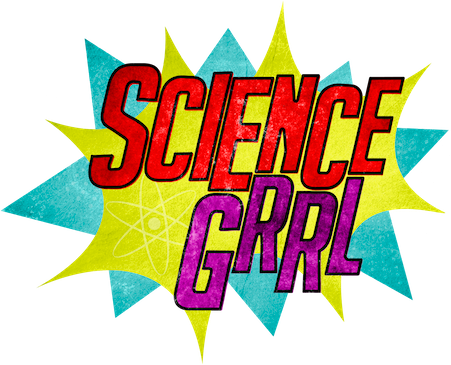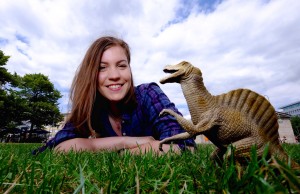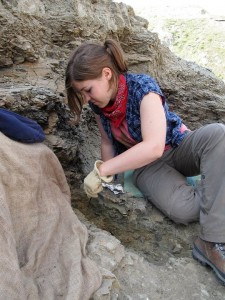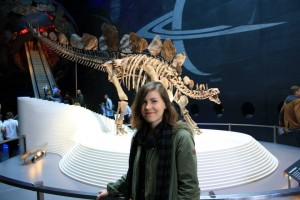Pleased to Meet You…. Franzi Sattler
Hello! Who are you, what’s your job title and what do you do all day?
Hello! My name is Franzi, I just turned 28, and I was born and raised in Berlin, Germany. I’m currently a 2nd year Master student and this summer I will get my M.Sc. in Evolutionary Biology, Biodiversity and Ecology.
I started my work as an intern in the Museum für Naturkunde (Natural History Museum) Berlin after a gap year in London as an Au-‐Pair. I was pretty much the only non-‐student who has ever interned there, to my knowledge!
The same autumn I started my undergrad degree in Geology. I never really left my position at the museum during my academic career, and now I am currently writing my Master thesis on our new Tyrannosaurus rex, Tristan. I’ve always been really into teeth (my favourite things to find in field work), so my Bachelor thesis and my Master teethis (see what I did there!) were all about the upper and lower jaw of dinosaurs.
I’m currently a research assistant at the MfN and basically look at CT scans of Tristan’s skull all day. Because this is such a complete specimen (the skull is 98% complete), I want pay special attention to poorly studied parts of the jaw and because our T. rex also shows abnormalities. I have gotten a new-‐found interest in Paleopathology. It is very likely that he/she had a tumour! How cool is that?
Is your work office based? Medical based? Fieldwork based? A mixture?
A mixture! Right now I usually sit more in the office and work with medical software to look at the CT scans, but I was lucky enough to do quite a lot of field work early in my career. In 2010, I was chosen to join the Museum of the Rockies for field work in Montana. I fell in love with that state and eventually moved there for a year. Last summer (2015) the MfN took me back there, this time to the Hell Creek Formation where Tristan was found.
I worked at the Museum für Naturkunde for free for most of my time there. I started in January 2009. I am currently paid to work on the Tristan Project as a student assistant. However, I also work at the Botanical Garden Herbarium in Berlin, and I work in the International Office of my university where I supervise exchange students and organize events. So yeah, I work a lot!
Is this what you wanted to do, or did it happen by accident?
This is something I have always wanted to do since I was a little girl. Palaeontology has always been my primary interest and I still sometimes can’t believe I am actually doing it. After my A-‐levels, I took a year off to move to London. I lived there for around 14 months with a lovely family in North London where I looked after a little girl. I never wanted to work with kids to be honest, but it has made me grow up a lot. I didn’t want to go straight to university. I didn’t feel ready to dive straight into academia, so I joined the MfN as an intern and it just progressed from there.
I am the only academic in my family. I’ve been the first one to live abroad, and the first one to go to college and university. My family has never been suuuuper into what I am doing. They’re proud and think I’m the smartest girl alive, but they don’t really understand it!
My boyfriend (@protohedgehog) is also a palaeontologist. He’s currently finishing up his PhD at Imperial College, so we are both extremely busy. It is very nice to have someone who knows what you are doing though, and who isn’t rolling their eyes when you talk about dinosaurs (again)!
Is being a woman in your field unusual? What’s the gender balance like?
I think more and more women are doing vertebrate palaeontology now. It used to be very rare to actually see a woman around (and in some cases it still is). When I specialized for palaeo during my undergrad degree, I was the only woman there. However, I have always preferred to have women as my mentors, and my supervisor of the past seven years is a woman. I actively seek out other palaeo girls on Twitter and love to share my experiences with them. I would say there are still many more men in this field, but the gender balance is slowly becoming much better.
Do you do any work to communicate your science to others?
I frequently do outreach at the MfN and my university. We have something called “Long Night of Science“ and also “Long Night of Museums“ in Berlin, where twice a year, the institutions are open to the public all night. I conduct special tours, and I recently had my own little booth where I taught visitors about the diet of dinosaurs and showed them different kinds of teeth.
Because I am pretty active on Twitter and do a bit of SciComm, the British Council has actually now invited me to apply for FameLab 2016 in Germany. I’ll consider it, but I am definitely still a bit too shy for this kind of stuff. I have always primarily used Twitter to communicate with people and share things I find interesting, but nothing beats the personal contact with children and families who are interested in science. This is what I really enjoy and social media cannot really compete with that (for me personally).
I don’t have a blog, but I might start one if I get a PhD. Just to document my journey and maybe someday look at it and think “wow, you really cried a lot those three years”! During the last Society of Vertebrate Paleontology meeting in Dallas, I also live tweeted for the PLOS Paleo Twitter account.
You can follow @ohyeahfranzi on Twitter, and also find out more at
https://figshare.com/authors/Franziska_Sattler/809109



